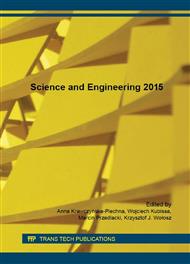[1]
D. Avnir, O. Biham, D. Lidar, Malcai, Is the geometry of nature fractal? Science. 279 (1998) 39-40.
DOI: 10.1126/science.279.5347.39
Google Scholar
[2]
P.J. Barrett, The shape rock particles, a critical review, Sedimentology. 27 (1980) 291-303.
DOI: 10.1111/j.1365-3091.1980.tb01179.x
Google Scholar
[3]
F. D. Bianchi, R. D. Bonetto, FERImage: an interactive program for fractal dimension, dper and dmin calculation, Scanning. 23 (2001) 193-197.
DOI: 10.1002/sca.4950230305
Google Scholar
[4]
C.R.I. Clayton, C.O.R. Abbiredy, R. Schiebel, A method of estimating the form of coarse particulates, Geotechnique. 59 (2009) 493-501.
DOI: 10.1680/geot.2007.00195
Google Scholar
[5]
M. Ćwik, K. Jóźwiak, A. Mariański, Introduction to the application of the theory of chaos in risk management (Wprowadzenie do zastosowania teorii chaosu w zarządzaniu ryzykiem), Zeszyty Naukowe Politechniki Śląskiej, Organizacja i Zarządzanie. 57 (2011).
Google Scholar
[6]
T. J. Dennis, N. G. Dessipris, Fractal modelling in image texture analysis, Radar and Signal Processing, IEE Proceedings F. 136 (1989) 227-235.
DOI: 10.1049/ip-f-2.1989.0036
Google Scholar
[7]
H. M. French, The Periglacial Environment, 3rd ed. Wiley, Chichester. (2007).
Google Scholar
[8]
M. K. Hassan, J. Kurths J., Can randomness alone tune the fractal dimension?, Physica A. 315 (2002) 342-352.
DOI: 10.1016/s0378-4371(02)01242-6
Google Scholar
[9]
U. C. Herzfeld, C. Overbeck, Analysis and simulation of scale-dependent fractal surfaces with application to seafloor morphology, Computers & Geosciences. 25 (1999) 979-1007.
DOI: 10.1016/s0098-3004(99)00062-x
Google Scholar
[10]
J. Konkol, The application of fractal geometry for the evaluation of building materials (Wykorzystanie geometrii fraktalnej do oceny materiałów budowlanych), Izolacje. VII/VIII (2011) 17-24. (in Polish).
Google Scholar
[11]
D. H. Krinsley, J. C. Doornkamp, Atlas of quartz sand surface textures, Cambrige Univ. Press. (1973).
Google Scholar
[12]
J. Kudrewicz, Fractals and chaos (Fraktale i chaos), Wydawnictwo Naukowo-Techniczne, Warszawa. 2007. (in Polish).
Google Scholar
[13]
W. C. Mahaney, Atlas of sand grain surface textures and applications, Oxford Univ. Press. (2002).
Google Scholar
[14]
B. B. Mandelbrot, The fractal geometry of nature. Freeman and Company, New York. (1983).
Google Scholar
[15]
E. Mycielska-Dowgiałło, The influence of climatic conditions on the structural and textural characteristics of mineral deposits (Wpływ warunków klimatycznych na cechy strukturalne i teksturalne osadów mineralnych), in: A. Karczewski, Z. Zwoliński (Eds. ) – The functioning of geosystems under different morphoclimatic conditions - monitoring, security, education (Funkcjonowanie geosystemów w zróżnicowanych warunkach morfoklimatycznych – monitoring, ochrona, edukacja), Poznań. (2001).
Google Scholar
[16]
E. S. Oczeretko, Fractal dimension in the analysis of biomedical signals and images (Wymiar fraktalny w analizie sygnałów i obrazów biomedycznych), Wydawnictwo Uniwersytetu w Białymstoku, Białystok. 2006. (in Polish).
Google Scholar
[17]
Z. Omiotek, Application of fractal dimension to contour analysis of objects (Zastosowanie wymiaru fraktalnego do analizy konturu obiektów), Informatyka, Automatyka, Pomiary w Gospodarce i Ochronie Środowiska, 2 (2012) 8-11. (in Polish).
DOI: 10.5604/20830157.1121333
Google Scholar
[18]
H. O. Peitgen, H. Jürgens, D. Saupe, The boundaries of chaos. Fractals. Part 1 (Granice chaosu. Fraktale. Część 1), Wydawnictwo Naukowe PWN, Warszawa. 1997. (in Polish).
Google Scholar
[19]
K. C. Rose, J. K. Hart, Subglacial comminution in the deforming bed: Inferences from SEM analysis, Sediment. Geol. 20 (2008) 87–97.
DOI: 10.1016/j.sedgeo.2007.11.003
Google Scholar
[20]
M. Sharp, B. Gomez, Processes of debris comminution in the glacial environment and implication for quartz sand grain micromorphology, Sediment Geol. 4 (1986) 33–47.
DOI: 10.1016/0037-0738(86)90004-7
Google Scholar
[21]
B. J. Super, A. C. Bovik, Localized measurement of image fractal dimension using Gabor filters, J. Vis. Commun. Image R. 2 (1991) 114-128.
DOI: 10.1016/1047-3203(91)90002-w
Google Scholar
[22]
S. Szerakowska, Parameters describing soil particle shape and analytical methods of their determination (Parametry kształtu ziaren gruntowych oraz analityczne sposoby ich wyznaczania), Przegląd Geologiczny. 62 (2014) 704-714. (in Polish).
Google Scholar
[23]
P. Tolppanen, O. Stephansson, L. Stenlid, 3-D degradation analysis of railroad ballast, B. Eng. Geol. Environ. 61 (2002) 35-42.
DOI: 10.1007/s100640100140
Google Scholar
[24]
B. Woronko, Micromorphology of quartz grains as a tool in the reconstruction of periglacial environment, in: P. Churski (Eds. ) – Contemporary Issues in Polish Geography. (2012) 111-131.
Google Scholar
[25]
T. Xu, I. D. Moore, J. C. Gallant, Fractals, fractal dimensions and landscapes – a review, Geomorphology. 8 (1993) 245-262.
DOI: 10.1016/0169-555x(93)90022-t
Google Scholar


